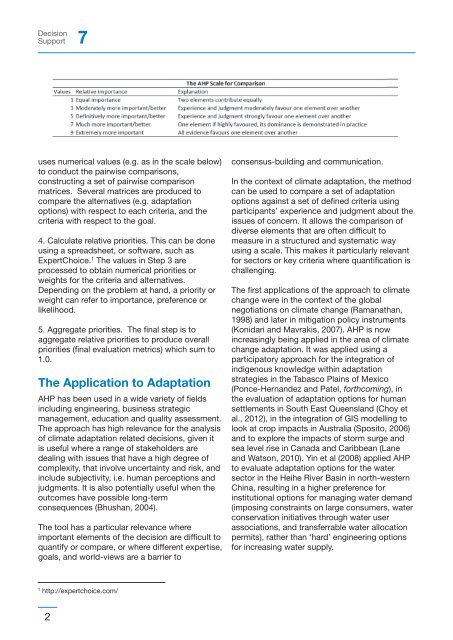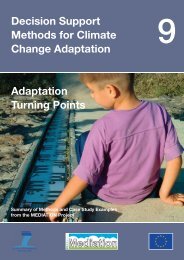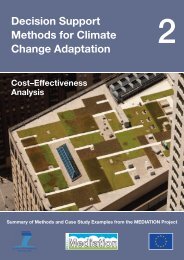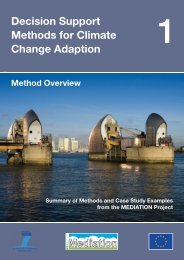Download all Technical Policy Briefing Notes in a single ... - Mediation
Download all Technical Policy Briefing Notes in a single ... - Mediation
Download all Technical Policy Briefing Notes in a single ... - Mediation
- No tags were found...
You also want an ePaper? Increase the reach of your titles
YUMPU automatically turns print PDFs into web optimized ePapers that Google loves.
DecisionSupport 7uses numerical values (e.g. as <strong>in</strong> the scale below)to conduct the pairwise comparisons,construct<strong>in</strong>g a set of pairwise comparisonmatrices. Several matrices are produced tocompare the alternatives (e.g. adaptationoptions) with respect to each criteria, and thecriteria with respect to the goal.4. Calculate relative priorities. This can be doneus<strong>in</strong>g a spreadsheet, or software, such asExpertChoice. 1 The values <strong>in</strong> Step 3 areprocessed to obta<strong>in</strong> numerical priorities orweights for the criteria and alternatives.Depend<strong>in</strong>g on the problem at hand, a priority orweight can refer to importance, preference orlikelihood.5. Aggregate priorities. The f<strong>in</strong>al step is toaggregate relative priorities to produce over<strong>all</strong>priorities (f<strong>in</strong>al evaluation metrics) which sum to1.0.The Application to AdaptationAHP has been used <strong>in</strong> a wide variety of fields<strong>in</strong>clud<strong>in</strong>g eng<strong>in</strong>eer<strong>in</strong>g, bus<strong>in</strong>ess strategicmanagement, education and quality assessment.The approach has high relevance for the analysisof climate adaptation related decisions, given itis useful where a range of stakeholders aredeal<strong>in</strong>g with issues that have a high degree ofcomplexity, that <strong>in</strong>volve uncerta<strong>in</strong>ty and risk, and<strong>in</strong>clude subjectivity, i.e. human perceptions andjudgments. It is also potenti<strong>all</strong>y useful when theoutcomes have possible long-termconsequences (Bhushan, 2004).The tool has a particular relevance whereimportant elements of the decision are difficult toquantify or compare, or where different expertise,goals, and world-views are a barrier toconsensus-build<strong>in</strong>g and communication.In the context of climate adaptation, the methodcan be used to compare a set of adaptationoptions aga<strong>in</strong>st a set of def<strong>in</strong>ed criteria us<strong>in</strong>gparticipants’ experience and judgment about theissues of concern. It <strong>all</strong>ows the comparison ofdiverse elements that are often difficult tomeasure <strong>in</strong> a structured and systematic wayus<strong>in</strong>g a scale. This makes it particularly relevantfor sectors or key criteria where quantification isch<strong>all</strong>eng<strong>in</strong>g.The first applications of the approach to climatechange were <strong>in</strong> the context of the globalnegotiations on climate change (Ramanathan,1998) and later <strong>in</strong> mitigation policy <strong>in</strong>struments(Konidari and Mavrakis, 2007). AHP is now<strong>in</strong>creas<strong>in</strong>gly be<strong>in</strong>g applied <strong>in</strong> the area of climatechange adaptation. It was applied us<strong>in</strong>g aparticipatory approach for the <strong>in</strong>tegration of<strong>in</strong>digenous knowledge with<strong>in</strong> adaptationstrategies <strong>in</strong> the Tabasco Pla<strong>in</strong>s of Mexico(Ponce-Hernandez and Patel, forthcom<strong>in</strong>g), <strong>in</strong>the evaluation of adaptation options for humansettlements <strong>in</strong> South East Queensland (Choy etal., 2012), <strong>in</strong> the <strong>in</strong>tegration of GIS modell<strong>in</strong>g tolook at crop impacts <strong>in</strong> Australia (Sposito, 2006)and to explore the impacts of storm surge andsea level rise <strong>in</strong> Canada and Caribbean (Laneand Watson, 2010). Y<strong>in</strong> et al (2008) applied AHPto evaluate adaptation options for the watersector <strong>in</strong> the Heihe River Bas<strong>in</strong> <strong>in</strong> north-westernCh<strong>in</strong>a, result<strong>in</strong>g <strong>in</strong> a higher preference for<strong>in</strong>stitutional options for manag<strong>in</strong>g water demand(impos<strong>in</strong>g constra<strong>in</strong>ts on large consumers, waterconservation <strong>in</strong>itiatives through water userassociations, and transferrable water <strong>all</strong>ocationpermits), rather than ‘hard’ eng<strong>in</strong>eer<strong>in</strong>g optionsfor <strong>in</strong>creas<strong>in</strong>g water supply.1http://expertchoice.com/2





